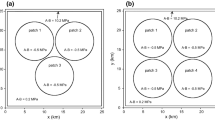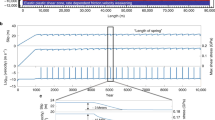Abstract
The dynamic motions and stabilities of a single-degree-of-freedom elastic system controlled by different friction laws are compared. The system consists of a sliding block connected to an elastic spring, driven at a constant velocity. The friction laws are a laboratory-inferred friction law called the rate-and-state-dependent friction law, proposed by Dieterich and Ruina, and a simple friction law described by dynamic and static frictions. We further extend the solution to a one-dimensional mass-spring model which is an analog of a fault controlled by the rate-and-state-dependent friction law. This model predicts non uniform slip and stress drop along the rupture length of a heterogeneous fault. This result is very different from some earlier modelings based on the simple friction law and a slip weakening friction law. In those earlier modelings the stress and slip functions become smoother with time along the length of the fault rupture, owing to the interactions between fault segments during slip. Because of this smoothing process the number of small events will decrease with time, and the universilly observed stationary magnitude-frequency relation cannot be explained. The interaction between a fault segment and its neighboring segments can be measured when the post-slip stress on this segment is compared with the stress on an identical segment (represented by a block in this modeling) without neighboring segments. If the post-slip stress of the former is much higher than that of the latter, strong interaction exists; if the two are close, only weak interaction exists. The interaction is determined by the relative motion between fault segments and the time duration of interaction. Our new modeling with the rate-and-state-dependent friction law appears to show no such smoothing effect and provides a physical mechanism for the roughening process in the difference between the fault strength and stress that is necessary to explain the observed stationary magnitude-frequency relation. The noninstantaneous healing predicted by the rate-and-state-dependent friction law may be repsonsible for the recurring nonuniform slip and stress drop, and may be explained by the reduction of interaction among fault segments due to the low frictional strength during the fault stopping. The very low friction during slip stopping allows much longer times than does the higher friction due to instantaneous healing for the fault segments to adjust their motions from an upper-limit slip velocity to almost rest. According to newton's second law, a process with fixed masses and constant velocity changes involves low forces and weak interactions if it is accomplished in a long time period, and vice versa. Our modeling also indicates that the existence of strong patches with higher effective stress on a fault is needed for the occurrence of major events. The creeping section of a fault, such as the one along the San Andreas fault in central California, on the other hand, can be simulated with the rate-and-state-dependent friction law by certain model parameters, which, however, must not include strong patches. In this case small earthquakes and aseismic creep relieve the accumulating strain without any large events.
Similar content being viewed by others
References
Aki, K. (1979),Characterization of barriers on an earthquake fault. J. Geophys. Res.84, 6140–6148.
Aki, K. (1983),Theory of earthquake prediction with special reference to monitoring of the quality factor of lithosphere by the coda method, submitted Proc. U.S.-Japan Symp. Earthq. Prediction, Tokyo.
Aki, K. (1984),Asperities, barriers, characteristic earthquakes and strong motion prediction. J. Geophys. Res.89, 5867–5872.
Andrews, D. J. (1975),From antimoment to moment: Plane-strain models of earthquakes that stop. Bull. Seismol. Soc. Am.65, 163–182.
Andrews, D. J. (1978),Coupling of energy between tectonic processes and earthquakes. J. Geophys. Res.83, 2259–2264.
Brune, J. E. (1970),Tectonic stress and the spectra of seismic shear waves from earthquakes. J. Geophys. Res.75, 4997–5009.
Burridge, R. andKnopoff, L. (1967),Model and theoretical seismicity. Bull. Seismol. Soc. Am.57, 341–371.
Byerlee, J. D. (1970),The mechanics of stick-slip. Tectonophysics9, 475–486.
Byerlee, J. D. (1978),Friction of rocks. Pure Appl. Geophys.116, 615–626.
Cao, T. andAki, K. (1984),Seismicity simulation with a mass-spring model and a displacement hardening-softening friction law. Pure Appl. Geophys.122, 10–24.
Cao, T. andAki, K. (1986),Effect of slip rate on stress drop, Pure Appl. Geophys., in press.
Cohen S. C. (1977),Computer simulation of earthquakes. J. Geophys. Res.82, 3781–3796.
Cohen, S. (1979),Numerical and laboratory simulation of fault motion and earthquake occurrence. J. Geophys. Res.17, 61–72.
Das, S. andAki K. (1977),Fault planes with barriers: A versatile earthquake model. J. Geophys. Res.82, 5648–5670.
Dieterich, J. H. (1972),Time dependent friction as a possible mechanism for aftershocks. J. Geophys. Res.77, 3771–3781.
Dieterich, J. H. (1979),Modeling of rock friction. I: Experimental results and constitutive equations. J. Geophys. Res.84, 2161–2168.
Dieterich, J., ‘Experimental and model study of fault constitutive properties,’ ASME Appl. Mech. Div., inSolid Earth Geophysics and Geotechnology (ed., S. Nemat-Nasser), New York, 1980, pp. 21–29.
Dieterich, J., ‘Constitutive properties of faults with simulated gouge,’ inMechanical Behavior of Crustal Rocks, Monograph 24 (eds., N. L. Carter, M. Friedman, J. M. Logan and D. W. Stearns), Amer. Geophys. Union, 1981, pp. 103–120.
Eshelby, J. D. (1957),The determination of the elastic field of an ellipsoidal inclusion, and related problems. Proc. Roy. Soc. London, Ser. A,241, 376–396.
Gu, J., Rice, J. R., Ruina, A. L. andTse S. T. (1984),Slip motion and stability of a single degree of freedom elastic system with rate and state dependent friction. J. Mech. Phys. Solids32, 167–196.
Kanamori, H. (1972),Determination of effective tectonic stress associated with earthquakes faulting: The Tottori earthquake of 1943. Phys. Earth. Plant. Inter.5, 426–434.
Kanamori, H. andStewart, G. S. (1978),Seismological aspects of the Guatemala earthquake of February 4, 1976. J. Geophys. Res.83, 3427–3434.
Kasahara, K.,Earthquake Mechanics. Cambridge Univ. Press, 1981, pp. 248.
Knopoff, L., Mouton, J. O. andBurridge, R. (1973),The dynamics of a one-dimensional fault in the presence of friction. Geophys. J. Roy. Astr. Soc.35, 169–184.
Mikumo, T. andMiyatake, T. (1978),Dynamical rupture process on a three-dimensional fault with non-uniform frictions, and near-field seismic waves. Geophys. J. Roy. Astr. Soc.54, 417–438.
Mikumo, T. andMiyatake, T. (1979),Earthquake sequences on a frictional fault model with non-uniform strengths and relaxation times. Geophys. J. Roy. Astr. Soc.59, 497–522.
Mikumo, T. andMiyatake, T. (1983),Numerical modeling of space and time variations of seismic activity before major earthquakes. Geophys. J. Roy. Astr. Soc.74, 559–583.
Ohnaka, M. (1973),Experimental studies of stick-slip and their application to the earthquake source mechanism. J. Phys. Earth21, 285–303.
Ohnaka, M. (1974),A physical understanding of the earthquake source mechanism. Part II: The fault-slip velocity and acceleration. J. Phys. Earth22, 382–394.
Otsuka, M. (1972),A simulation of earthquake occurrence. Phys. Earth Planet. Interiors6, 311–315.
Papageorgiou, A. S. andAki, K. (1983),A specific barrier model for the quantitative description of inhomogeneous faulting and the prediction of strong ground motion. Part II: Applications of the model. Bull. Seis. Soc. Am.73, 953–978.
Rice, J. R. andGu, J. (1983),Earthquake after-effects and triggered seismic phenomena. Pure Appl. Geophys.121, 187–219.
Rice, J. R. andRuina, A. L. (1983),Stability of steady frictional slipping. Trans. ASME, J. Appl. Mech.50, 343–349.
Rice, J. R. andTse, S. T. (1986),Dynamic motion of a single degree of freedom system following a rate and state dependent friction law. J. Geophys. Res.91, 521–530.
Ruina, A. (1980),Friction Laws and Instabilities: A Quasi-Static Analysis of Some Dry Friction Behavior, Ph.D. Thesis, Brown University.
Ruina, A. (1983),Slip instability and state variable friction laws. J. Geophys. Res.88, 10359–10370.
Ruina, A., ‘Constitutive relations for frictional slip,’ inMechanics in Geomaterials (ed. Z. P. Bazant), John Wiley, New York, 1984.
Swhwartz, D. P. andCoppersmith, K. J. (1984),Fault behavior and characteristic earthquakes: Examples from the Wasatch and San Andreas fault zones. J. Geophys. Res.89, 5681–5698.
Stuart, W. D. (1979a),Strain softening prior to two-dimensional strike-slip earthquakes. J. Geophys. Res.84, 1063–1070.
Stuart, W. D. (1979b),Aging and straining softening model for episodic faulting. Tectonophysics,52, 613–626.
Stuart, W. D., andMavko, G. (1979),Earthquake instability on a strike-slip fault. J. Geophys. Res.84, 2153–2160.
Tse, S. T. andRice, J. R. (1986),Crustal earthquake instability in relation to the depth variation of frictional slip properties, J. Geophys. Res.,91, 9452–9472.
Tullis, T. E. andWeeks, J. D. (1986),Constitutive behavior and stability of frictional sliding of granite. Pure Appl. Geophys.,124, 383.
Weeks, J. D. andTullis, (1985),Frictional sliding of dolomite: A variation in constitutive behavior. J. Geophys. Res.90, 7821–7826.
Wesson, R. L., Burford, R. O. andEllsworth, W. L. (1973),Relationship between seismicity, fault creep and crustal loading along the central San Andreas fault Proc. Conf. tectonic problems San Andreas fault system, V.
Wesson, R. L. andEllsworth, W. L. (1973),Seismicity preceding moderate earthquakes in California. J. Geophys. Res.78, 8527–8546.
Wilson, E. L. andClough, R. W. (1962),Dynamic response by step-by-step matrix analysis. Paper 45, Symp. Use Computers in Civil Engineering, Lisbon, October 1962, Laboratorio National de Engenharia Civil, Lisbon, Portugal, pp. 1–14.
Yamashita, T. (1976),On the dynamical process of fault motion in the presence of friction and inhomogeneous initial stress. I: Rupture propagation. J. Phys. Earth24, 417–444.
Author information
Authors and Affiliations
Rights and permissions
About this article
Cite this article
Cao, T., Aki, K. Seismicity simulation with a rate- and state-dependent friction law. PAGEOPH 124, 487–513 (1986). https://doi.org/10.1007/BF00877213
Received:
Revised:
Accepted:
Issue Date:
DOI: https://doi.org/10.1007/BF00877213




